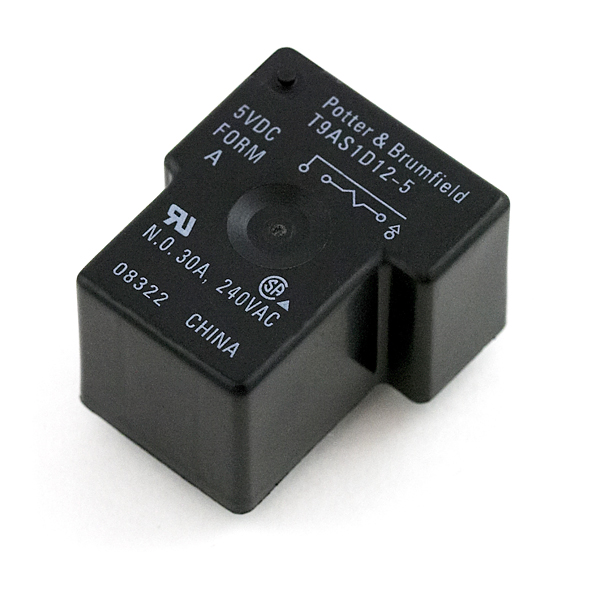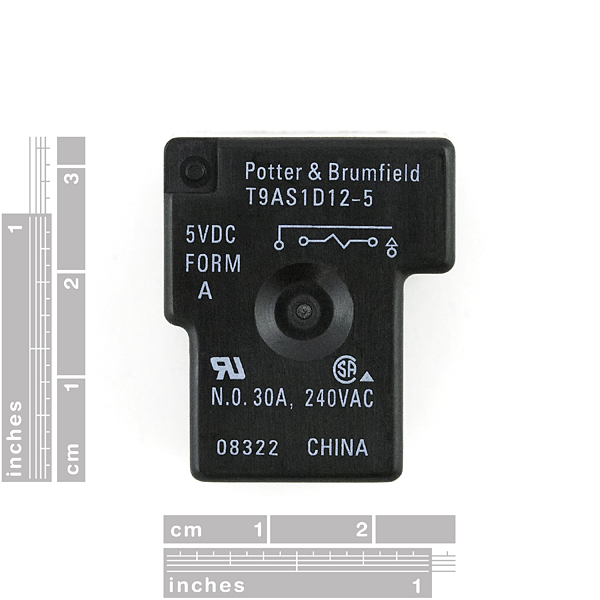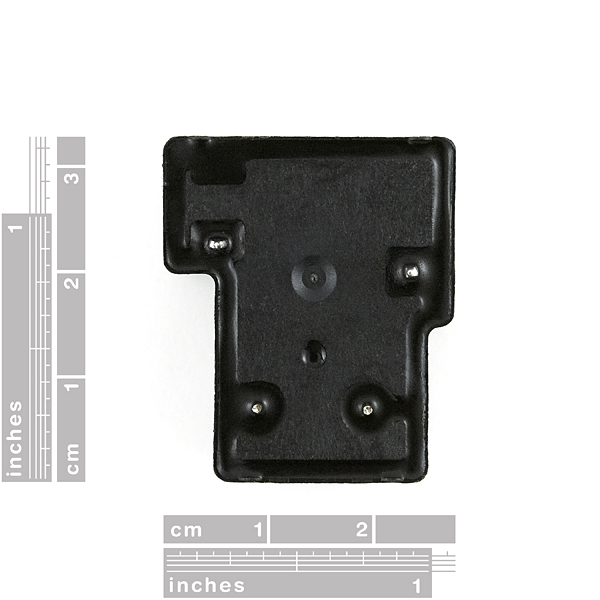Relay SPST-NO Sealed - 30A
Replacement:COM-10924. We don't carry these relays anymore but we still carry a similar relay rated for 20A. This page is for reference only.
These are massive Single Pole - Single Throw (SPST) Normally Open (NO) sealed relays from Potter and Brumfield. Use them to switch high voltage/high current devices.
Checkout the outlet tutorial to see how to use this large relay.
- SPST-NO Relay
- Rated up to 220VAC @ 30A
- Fully Sealed
Comments
Looking for answers to technical questions?
We welcome your comments and suggestions below. However, if you are looking for solutions to technical questions please see our Technical Assistance page.
Customer Reviews
No reviews yet.




I've used a version of this part with spade terminals for the load on top of the package (datasheet says '.250" (6.35mm) quick connects for contacts', see the part number decoder there.)
When working with a high voltage AC load, I'd definitely prefer & recommend that version of the part, as it allows you to keep the hot connections entirely isolated from the PCB.
Are these coming back in stock soon? Hope so -- I have a project waiting on them.
Thanks!
So do I. :(
Need more relays.... please?
These are great. I would like to see a DPST version of this for U.S. 2 phase 240 volt circuits.
The PCB you stock for this isn't so good though, aside from the pins not quite lining up, the traces are not near heavy enough for even 10-12 amps @ 120V continuous.
Even if it had a simpler way to add heavy jumpers would help.
Can these be used in the UK with 230VAC?
yes, the difference between US and UK is the frequency: 60 Hz in the US versus 50 Hz in the UK. The relay wouldn't care either way.
Anyone know the maximum voltage which would be safe to use on this. I see that its a 5v relay, but if i use 6-8 will it be ok?
from the data sheet
Coil Data @ 25°C
Voltage: 5 to 110VDC
So you're fine in the 6-8 range.
For 220VAC use, it would be great to have a DPST-NO relay - that way both hot legs would be isolate when the relay was off (open), rather than leaving one side hot.
Any plans for adding a 220VAC@30A DPST to the product list?
I am pretty sure the IO pins on the Arduion output at 40mA per pin actually. http://arduino.cc/en/Main/ArduinoBoardDuemilanove
From the above link:
They operate at 5 volts. Each pin can provide or receive a maximum of 40 mA and has an internal pull-up resistor (disconnected by default) of 20-50 kOhms.
These work off of 5V no problem from my experience and I have them setup and working on my Arduino. I built a few of the boards detailed on your Controllable power outlet tutorial here (http://www.sparkfun.com/commerce/tutorial_info.php?tutorials_id=119)
I've looked at the datasheet and I'm confused by the coil data tables. The arduino can switch a few of these no problem. I'm wondering if it can switch 8 or more?
This really is more a question about the Arduino. You may just have to try it out and see what you find. Measure the current draw on a single one, and see if it can handle 8 times that. My guess is you will have a dead Arduino pretty quickly. You should forward any additional questions directly to techsupport@sparkfun.com.
Looking at the spec sheet I can't find how much power this draws. I'm trying to figure out how many of these I could turn on at once from the Arduino.
turn on a smaller transistor with the arduino that sends power to this relay
The first page of the datasheet shows current draw from the coil. The Arduino can only supply about 20mA per pin, which is nowhere near enough for a single relay.
Anyone have any ideas how fast this relay can be switched? Max. frequency of ON/OFF. I tried looking at the specs, but for the likes of me could not find any numbers..or am I just blind. Any help appreciated!
Bottom right of the first page says 15ms
Thanks Wakkow! I am blind!
In the tutorial they use this relay to switch an AC load. I want to switch a 12V DC load that needs about 10A. This would work to switch a DC-powered load, right..?
Or maybe a better question: how does the current rating change with a DC load vs AC? There seem to be some different stats in the datasheet.
I read the datasheet and comments, but still wonder if this is the right part for my application.
I want to hook this up to switch power to a dc subpanel in my car. So I want this to close when I turn on the ignition (I have a switched wire to tap into), and when it closes, it completes a circuit of heavy wires hooked up directly to the battery. I see discussion about 5v and 12v to activate this relay, so that's really my question. Thanks!
Landonr: Hi, I just bought this relay, do I need to buy the pcb also to use it with my arduino or can I use it alone?
you could definitely use this alone... refer to the tutorial posted above. the basic 2 transistor switch could do the job.
Can i use this on a 1HP air conditioning?
here is my aircons specification:
http://i179.photobucket.com/albums/w313/kiashee/IMG_4447.jpg
I'm not good with the calculations regarding the increase current during startup. This is why i am doubting the specification of 30A-240V. it can be seen that my air conditioning is jut 4.18A.
Can anyone assure me to use this? :D
TIA.
In my GF's Hyundai Sonata the 12V plug below the radio is rated at (12V 10A 120W), that is how I remember.
Volt * Amps = Watt
Watt / Volt = Amps
Watt / Amps = Volt
So your A/C is rated at 208V/230V - 4.18A - 904W, and the relay is rated at 220V 30A.
A/C:
904W / 4.18A = 216V
Relay:
220V * 30A = 6,600W
I think it is well within limits, my only concern is the turn on spike in current, but I am sure it is fine.
Hi, I just bought this relay, do I need to buy the pcb also to use it with my arduino or can I use it alone?
Can anyone tell me if this relay works with 9V from a wall outlet? I've tried, but no luck. Thanks!
Sorry about that! We have switched to the 5V version. We should have cleared out all the previous stock. Contact customer service and they can replace that relay for you.
Just bought this, but now it seems I've misread the labels...
I need to switch +48 VDC at 8 A, will this relay be enough?
Advice is much appreciated!
Anyone?
In the datasheet I can only find 28VDC @ 20A referenced , could I assume it handles 48VDC @ 10A ? Also, I've got +5VDC @ 0.040A to trigger the relay - is this enough to fully close the circuit?
You says is a T9AS1D12-5 (coil 5v) but image is a T9AS1D22-12 (coil 12v), and you have send to me the T9AS1D22-12. Tutorial is referred to T9AS1D12-5, but you are selling T9AS1D22-12.